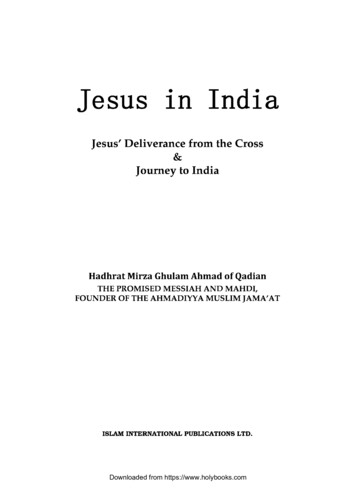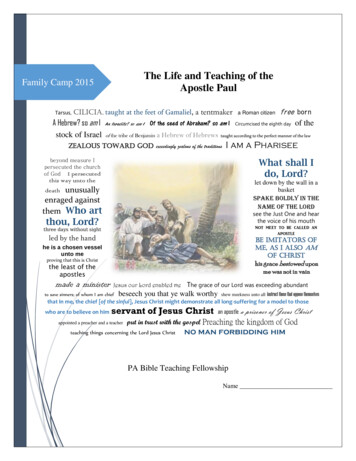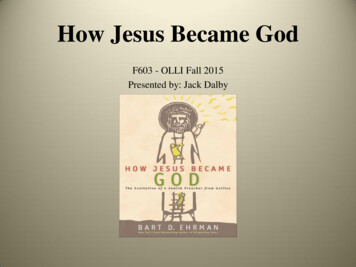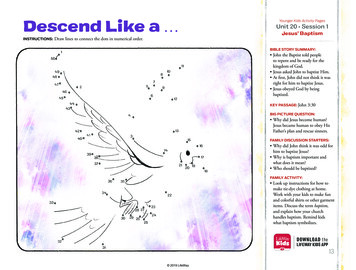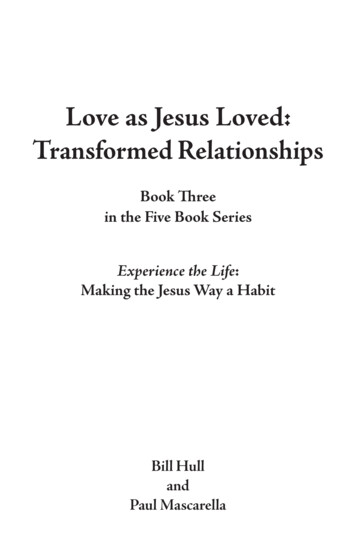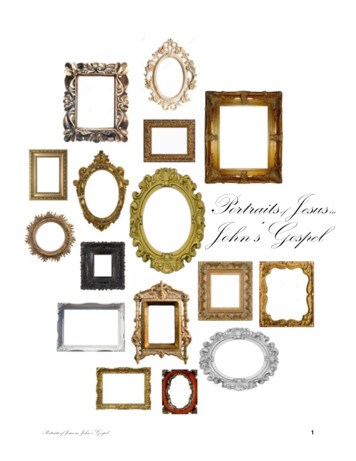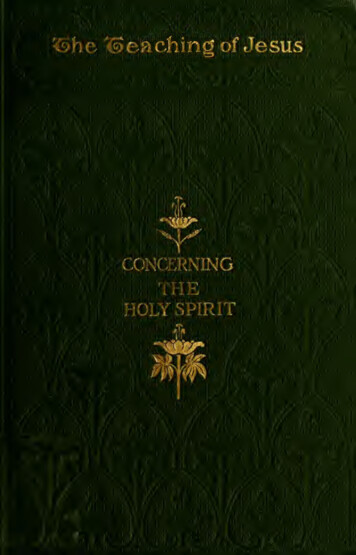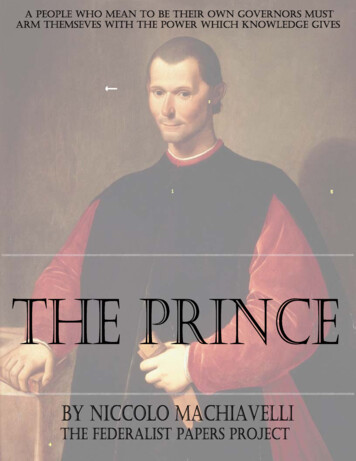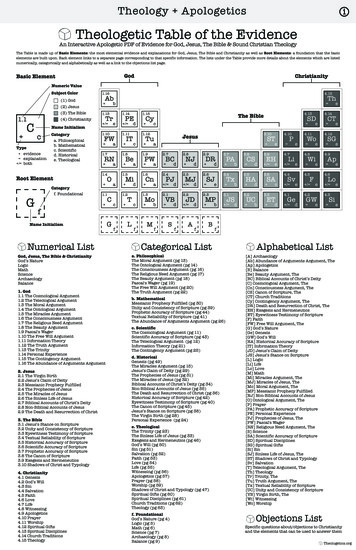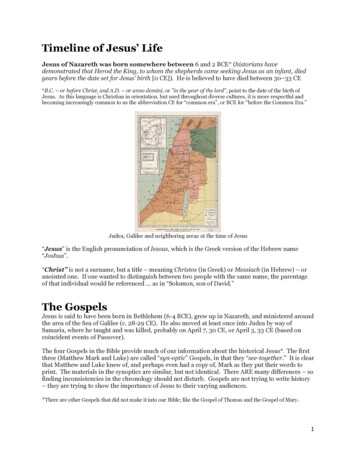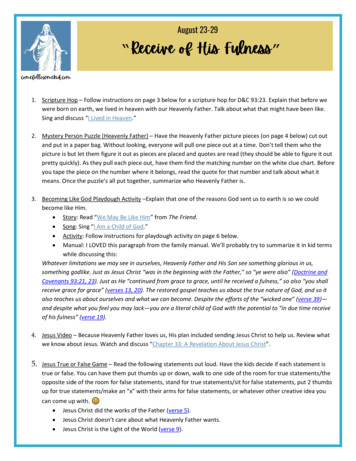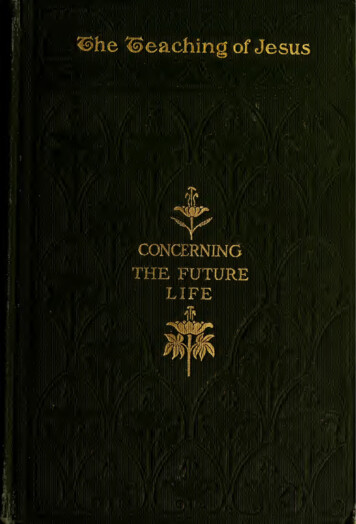
Transcription
Book.X j3f Copyright N?.COPYRIGHT DEPOSIT.
THE TEACHINGS OF JESUSJOHN H. KERR, D. D."Edited byTHE TEACHING OF JESUSCONCERNINGTHE FUTURE LIFEWillis Judson Beecher, D. D.
THE TEACHINGS OFJESUSCONCERNINGHISOWNMISSION.Frank H. Foster.Ready.THE KINGDOM OF GOD AND THECHURCH.Geerhardus Vos."GOD THE FATHER.ArchibaldThomasRobertson.THE SCRIPTURES. David James Burrell.THE HOLY SPIRIT.Louis B. Crane.CHRISTIAN CONDUCT.Andrew C."ZenosTHE CHRISTIANLIFE. Gerard B.F."HallockTHE FUTUREHISOWNLIFE.PERSON.WillisJ.Beecher."Wayland Hoyt.JESUS THE TEACHERA"""In -preparation. volumes on the "Teachings of Jesus"by eminent writers and divines.Series ofCloth bound.12mo.Price 75 ctseach postpaid.AMERICAN TRACT SOCIETY.
THE TEACHING OFJESUSCONCERNINGTHE FUTURELIFEByWillis Judson Beecher,D. D.AMERICAN TRACT SOCIETY 150NASSAU STREETNEW YORKC 0t
LIBRARY of CONGRESSTwoCopies ReceivedNOV 2 1906 CopyrfEtt EntryflaCUSSi,tACOPYfedXXCnNe,B.'wCopyright, 1906.By;American TractSociety,
CONTENTSPAGEI.Our Sourcesof Information.Before Jesus. Ethnical Ideasof a Future State.III. BeforeIsraelitishJesus.Ideas of a Future State.IV. Jesus Interpreting the OlderiII.7.22TeachingsV.VI.VII.VIII.IX.X.38The Kingdom and the FutureLifeSalvation and the FutureLifeRealities in the Future Life.Physical Expressions for theFuture LifeEternity and Immortality.The Resurrection of the Body.566684106125145XL The Judgment Day164XII. Cross Examination179187Indexes
CHAPTEROurISources of Information/T ROMj/*inHis own words, as recordedthe Gospels and in a few logiaextant elsewhere,we maywhat Jesus taught concerninglearna futurebut our sources are not limited tothese.In addition we have accounts oflifeHis;lifesomeand personal experiences, andof these bear—upon thelifethat fol-His miracles ofraising the dead, and His manifestationsof Himself after His own resurrection.lows deathFurther,particularlywe maythe teachingsbring into the questionwhich Hisearliestdisci-
The Future Life2promulgated in His name. As theywent everywhere preaching Christ, theirpreaching was to the effect that He hadrisen from the dead, and that He was tobe the Judge of men, who also exist inpiesStatements ofkind they reiterate and emphasize,amplifying them in numberless details.a life that follows death.thisIt isimpossible to think that they werewholly mistaken in testifying thatwere the teachings which Jesus hadmitted to them. So far forth aspresent a formulated theology, onestaple doctrinesisthesecomtheyofthat of a futureitslife,and of Jesus as dominating the future life.And even more marked, if that werepossible,isthe testimony they give in theform of indirect statements and implications.Directly and indirectly theirtheme is " Our Saviour Christ Jesus, whoabolished death, and brought life and incorruption to light through the gospel"(II Tim. i. 10).In this little volume, the citations from
OurSources of Information3other sources than the words of Jesus areused only for the light they throw uponHis teaching. Either they illustrate themeaning of the terms in which He expressed Himself, or they indicate whatthosewho werestoodHimHimnearest tounder-some otherknow what Heto teach, or inway they helpus totaught.HowThetorecordsuse the Sourcestheseofsourcesaremostly included in the New Testament,though some information may be gleanedelsewhere.Andcurrent criticismare to usethe gravest question ofthe questionisthese records.how wePersonallyIhave no doubt that the records are in thehighest degree trustworthy in their statements of fact. But I am confronted withmen who denythis,whoaffirm that alarge proportion of the statements are untrue, or are true only as ideaspresentingfacts.Iand not assome-desire to say
;:The Future Life4thing that shall carry conviction to menof this way of thinking, and not merelywhothosetoHowalready think ascan this be accomplishedIdo.?One whohas not given much thoughtproblem will probably replyWhy, the whole thing is very simpletothe;first settlethe question of the trustworth-your witnesses, and then taketheir testimony.But that is not theway they do in a court of justice. Theyiness oftake the testimony of the witnessfirst.Theydetermine the trustworthinesslargely by the nature of his testimonyitself, and by his manner of giving itand afterward by cross-examination andrebuttal and surrebuttal and other processes.Suppose we deal in the sameway with the New Testament writingsas witnesses concerning the teachings ofJesus.Ifleastsome one thinksthatmay supposably beapostlesit istrue, or attrue, thatand evangelists sometimestheat-
OurSources of Informationtribute to Jesus ideas thatthat in reportinggotHe did not holdHis ideas they sometimesthem mistakenly confused withown5or that Jesusuttered statements;theirmay sometimes haveHewhichwouldon second thoughthave revised, thatperson has a point of view different frommine. In case we study together hewould say that I ought not to expecthim to adopt my theory of the trustworthiness of the records, not even ifI regard the trustworthiness as a provenfact.But equally he ought not to expectme to adopt his theory of the untrustworthiness of the records, not even if heregardsitEvidentlyasthe only up-to-date idea.we mustbegin by leaving openthe questions on whichwediffer.Thethemselves constitute the oneundisputed fact in the case. No onerecordsdoubts thatthisfactexists,and in aDifferences of opinionconcerning its contents and text, howevernumerous, are so unimportant as to be amillion of details.
The Future Life6negligible quantity for the purposesinWehand.willwhat the recordsforconsiderationlaterby simplybeginascertainingnowsay, leavingthequestionwhether the teaching of Jesus concerningthe future life actually was what theit to have been.Ofour materials critically,but we will remember that an uncriticalrejection of a statement is as bad asan uncritical acceptance of it. By therecords representcoursewe will useprocess of carefully inquiring what therecords sayoneweshallapply toticallyworth more thanaccurately understandingwethem thetest for trustworthiness that is prac-shallprepareallothers.what theyourselvesBysayjudgetowhether it is characterized by consistencyandand soberness and verisimilitude;judge of the validity of any reasonsthat may be alleged for modifying italso toor refusing to believeit.
CHAPTERBefore Jesus.II—Ethnical Ideasof aFuture ebeliefcurrent, andsaid that Jesus firstamong mendeath.the beliefThisisahad previously beennot in Israel only, but inLong beforepre- Israelite civilizations.Abrahamit was a religious doctrine inEgypt and Babylonia and elsewhere. InHis human character Jesus inherited theideas on the subject that had been handeddown to Him from His predecessors.He found in existence certain opinions7
The Future Life8concerningWe can the betterit.His teachingifwedepictuse these previousteachings as a background.The Egyptian Book ofThe mosttheDeadauthentic source of informa-tion concerning the attitude of early relig-ions toward a life after deathprobablyof theDead."* To get an idea as to what theEgyptian priests taught concerning thecondition of a human being after death,one should turn over these volumes,should look at the numerous vignetteswith which the ancient Egyptian documents were illustrated, and should read atleast parts of the translated text.Theteachings concerning judgment afterdeath and punishment and reward andthe celebrated Egyptianis"Bookconditions of existence are voluminousandspecific.*NowTheteachings are differentconveniently accessible in more forms than one, andespecially in the popular edition publishedlisBudge in1901, in three small volumes.by Mr. E. A, Wal-
Ethnical Ideasfrom thosetowhich wegChristians are ac-customed, though they have many pointsof contact with ours. If one should makefrom thema tabulatedscheme of wrongsbe avoided and of duties and motives,scheme would be surprisingly inagreement with our Christian ethics.We feel an approving admiration forthe ethical intelligence and for the loftyreligious conceptions that appear, eventhough they are mingled with elementsand we feel a disapprovingless worthytothe;admiration for theskill in priestcraftpermeates and deterioratesthatthe whole.Everywhere appears the consciousnessthat a person's own merits, howevergreat, do not suffice for obtaining afavorable verdict from the judges of thedead, but must be supplemented bygood offices that the priesthood mayrender.Everywhere is the moral thatin one's lifetime one should be generousto the temples as the means of securinggood fortune after one's death. And
The Future Lifeioscheme was successful,and the temples heapedthe fact that thethat the priestsupriches and honors,issufficientproofthat the Egyptians believed in the realityof the teachings of their religion concern-ing the future.What was truewasalsoEgyptian religiontrue, with the requisite changesin theof terms, in other great early religions.In various ages and countries embalminghas been practised,and has been con-nected with the idea of preserving thebody for the use of the still surviving soul.Thedoctrine of the transmigration ofsouls haswithitslife afterbeen widely and variously held,implications of a certain kind ofdeath.The World of theDeadOne of the most universal of humanconceptions is that of the world of thedead.Perhaps this has its origin in a cerhuman thinking.materialist, who saystain essential necessity ofEven the crudest
nEthnical Ideasthat thought and feeling are merely thetransient result of certain conformationsof matter, and that personality vanisheswhenthethe body disintegrates, will nonelessspeak of his deceased friendassleeping in the grave, as having gone overto the great majority.sumethat death endsIfall,weshouldas-that neither thebodies nor the spirits of the dead are anylonger in existence, that there is nothingexcept certain particles of matter thatused to be in their bodies but have nowgone into different organisms nevertheless the remembrance of the dead is a reality, the emotions they stir in us are a reality, and their influence over us is a reality.are compelled to think of the dead asthe sources of these realities, and notmerely as so much decomposing matterthat has changed or is changing intosomething else. Much more do we thinkin this way if we hold that men are spiritual beings and not mere combinations ofteft;Wematter.As a mode of speaking, at least,as
The Future Life12a figure of speech,we construct a worldofthe dead, where the dead are conceivedof as existing and as having relations withthe universe, analagous to those whichliving persons have.Whether the habit of thinking arose inthis way or in some other, it is one of themost widespread of humanHebrewhas his sheol,habits.Thethe Greek hishades, the Anglo-Saxon his hell, and otherpeoples their world of the dead underother names.Andthemoment humanto talk in thisbeings beginway about the dead theybe-gin to let their imaginations play in theconstruction of the environmentwhichconstitutes the world of the dead.Theyand lakes and plainsThey speak of itsand mountains.occupations and its officials and its gods.They create for it Acheron and Styx andCharon and Pluto. To differentiate itsdiversifyitinhabitantswithriversfrom those of the realms ofthe living they are perhaps pictured as
Ethnical Ideas13shadows. It is overhung by the atmosphere of horror and gloom which is suggested by our natural fear of death and byIt must bethe sorrow that death brings.geographically located, and, by our natural way of thinking of the high and thelow, the place for it is not on the surfaceof the earth, nor in the sky, but beneath.The world of the dead becomes the underworld, the infernal region, often specifically asubterranean region.This mentalhanded downgeneration, and handedconstruction, once begun,isfrom generation toalong from race to race, constantly receiving accretions. Sometimes it is made theof serious spiritual meanings.Oftener the constructing process becomesgrotesque, and the regions of the dead arepeopled with beings as ridiculous as theyvehicleare frightful.lessthanisTo someextent,thoughcommonly assumed, menlosethe consciousness that the scenes thusconstructed are imaginary, and in a confusedway cometo regardthemas real.
;The Future Life14Therenothing in this to contradictwe have actual informa-isthe doctrine thattion,bydirectrevelation or otherwise,concerning human beings who have diedand nothing to contradict the opinionthat some of the stories concerning thenether world are nature myths, and thatothers may be legends with a historicalknowledge weand whatever ele-Whateverbasis.realhave on the subject,ments of myth or legend have enteredinto the treatments ofognize bytheitself thishuman mindceasingeffort instructs ahometionsandit,we needto rec-perpetual process ofin all ages, this neverwhich thought con-for the dead, with condi-interests,and limitationslikeand yet unlike those of the living.AnBabylonian poet sings howgoddess of love and of procreation,descends for some purpose into theearlyIshtar,world of the dead, passing through sevenstrongly barred gates, leaving her adorn-ments successivelyatone gateafter an-
Ethnical Ideasother, andcoming naked15into the pres-ence of the infernal goddess Eresh-Kigal,causes her to be afflicted with manywhodiseases.While shemen andanimals on earth cease to re-isdetained there,produce their kind, and are in danger ofbecoming extinct, and the gods have todevise a plan for the return of Ishtar.some points the Greekwhich Persephone is carried tothe lower world by its god Aidoneus,while her mother Demeter, the goddessThisparallels atstory inof the harvests,wanders in search of her,by reason of theleavingmento sufferfailingcrops.Anyclassicaldictionarygives us the story ofOrpheusvisiting theunderworld in search of his belovedEurydice, charming the infernal deitiesby his music, but failing because he cannot resist turning to look at her beforeHomer prethey reach the upper air.sents a detailed story of the visit of Ulyssesto the realms of the dead,the same for iEneas.Inand Virgil doessomeeditions
6The Future Life1of Josephusto theNorsewefind his alleged discourseGreeks concerning Hades.HermodstoriesvisitsIn thethe worldof the dead to procureBalder, buttoweepfailsthe release ofbecause one being refusesfor Balder.Narratives of this sort are inallearlyCommonly, but not always,they represent the world of the dead asunderground. Uniformly it is an abodeliteratures.ofgloom andpain,of punishment.tationsitand sometimes a placeIn some of the presen-includes a region of Tartarus,where men whoare displeasing to thegods suffer for their deeds, and a regionof Elysium where pleasures come to thosewhoare pleasing to the gods.Andit isnot merely a primitive way of thinkingPoets andthat long since ceased to exist.othersrenew the theme from generationDante's Inferno and Milton's Paradise Lost and Pollock's Courseof Time are repetitions of the themes ofHomer and Virgil. In Fenelon's Teleto generation.
;Ethnical Ideasmachusa visit to theis17world of shadeswhich exactly parallels those of theclassicFew of Matthew Arnold's poemspoets.more thanattract the readerhis BalderWithin a few years past Stephenreproduced the descent ofUlysses into Hades, and Jean Ingelowand Miss Sherwood have written charming poems on the theme of Demeter andDead.Phillips hasPersephone. In our current accounts ofthe happy hunting grounds of the American Indian, who is able to distinguish between the original tradition and theembellishment added by the white menwho have written on the subject?*Reality, or Figure of Speech ?What was* Readsomethe character of representaoftheliterarymasterpiecestheme, in a form as near the original asfor exampleon Ishtarinisonthispossible for you,George Smith's Chaldaean Accountof Genesis, pp. 226-236, or in other works on Babylonia onBalder in Matthew Arnold on Persephone in the Classical;;Dictionaries and in Persephone by Miss Margaret Sherwoodon Ulysses in the Odyssey XI and Ulysses by Stephen Phillipsthe Mneid VITelemachus XVIII.;B
8;The Future Life1tions of this kind, as they existed in earlytimes?Ina recentbook,The Greekby Mr. G. Lowes Dickinson, it is said " The mythology whichwe regard merely as a collection offables was to the Greeks actually trueor at least, to nine Greeks out of ten itwould never occur that it might be false,might be, as we say, mere stories." Tokeep this statement from being misleading, it needs all the limitations which theViewof Life,:author gives it in the context. Whenwe follow the current fashion and speakof early peoples as naive and childlike intheir beliefs,memberdren.weshould do well to re-that there are childrenAtandChristmas three or fourchillittlechildren out of twenty appreciate thefictitious character of Santaas their elders,Claus as wellthree or four are blindlycredulous, and the rest are in confusionWemind between the two attitudes.should also do well to remember that inmany matters of observation these earlyof
Ethnical Ideas19had better trained judgmentspeoplesthan we.Commonlyin the ethnical religions thedead was regarded asdepending on rites of sepulture. Untilthe body was buried or burned with duereligious ceremonies, it was held that thedeparted shade was wandering and restIn this there was anless and wretched.outreach of tender sentiment toward thedead, and it was one which the interestscondition of theof the priests did not requirethemtodiscourage.Itisimpossible accurately to dissectthe pre-Christian pictures of the worldof the dead, and decide what parts wereregarded as reality.Different personslooked at them differently. There wasin them an element of reality of thecharacter of natural fact.them an elementacterofmoralThere was soberThere wasinof reality of the char-andfigurethe presentation of thesespiritualtruth.of speechrealities.forThere
The Future Life20was the confusion that comes when menunderstand literally that which wasuttered figuratively. There was the deadding of pictorial features,often of grotesque features, to the repre-liberatesentation asitpreviously existed.Therewas again the attempt to understand sewhich had become fanciful.On the whole, the mechanical viewtaken by books of reference when theyriously thattellus that the ancient Babylonians orGreeks or Scandinavians or others heldsuch and such doctrines concerning afuture state, is to be but partially depended upon. Minds differ now anddiffered anciently in their conception ofsuch mattersas these.All the same such matters wereinent elements inhumangenerations before Jesus.scattered everywherecameownprom-thinking in theamongTheJews,the nationsinto contact with them, and theirthinking was affected by them.Romans andthe various Greek-speaking
Ethnical Ideaselementsthemofthe21populationbroughtinto Palestine in the time of Jesus.They were an elementinthe mentalfurniture of the persons withassociatedwhen onearth.whom He
CHAPTERIII—Before Jesus. Israelitish Ideas ofa Future StaterHEREno more marked charOld Testamentthan the relative absence from itisacteristic of theof suchphenomenaasthe preceding chapter.those treated inBothitssilencesand its utterances on this subject areworthy of careful attention.Sheol, theWorld of the DeadIt uses abundantly the conception ofthe world of the dead. The word Sheo/,the proper word for this conception, oc-22
;Israelitish Ideas23curs sixty-five times, and otherwords areused in the same sense, for ex-oftenample "thepit,""Abaddon.''It rep-an underworld, usingsuch phrases as " beneath,'"lowestSheol," "deeper than Sheol," "go downinto," "bring up from," "though theydig into Sheol " (e. g. Isa. xiv. 9Ps.resentsSheolas';lxxxvi. 13Amos;ix.Jobxi. 8, lyPs. xxx. 3instancesitssubterranean.darkness andgloom andperhaps in some passages a placeof punishment.Seven times the Old Testament denotes the inhabitants of the underworldby the noun rephaim, "giants," perhapsconceiving of them as abnormal, frightful beings, shadowy and unsubstantial,possibly as palpable to the eye and theear in some circumstances, but not tothe touch its representations being in;these respects similar toethnical traditions.those in the
The Future Life24But here the resemblances end. TheOld Testament is reticent. It omits details.It marks out no route by whichone can sail or ride or walk, as in thecase oftoUlysses orthe infernalCerberusferrymanHermodthe gate,ator iEneas,There is noand no Stygianregions.no Pluto or Frigga or Ereshkigal, or other god or goddess of Sheolno Minos and Rhadamanthus, judges ofthe dead no details of punishment, nowheel of Ixion or stone of Sisyphus orthirstof Tantalusno Tartarus and;;;Elysium.WhenProverbsrecent writer says thatavii.27 "Sheoldistinct divisions/ 'hedeath "beyondsaid toinhavestretching theisnatural figure of speechofis"the chambersallrecognition.When another speaks of " the old beliefthat in Sheol the dead would be knownby their dress, the king by his diadem,the soldier by his sword, the prophet byhis mantle/ citing Ezekiel xxxii. 27 and'
Israelitish IdeasISamuelxxviii.2514 in proof, he outragesthe fine pictorial language of Ezekiel byputtingitinto a mechanical strait-jacket.In the passage he refers to in Samuelno Sheol, and no recognizing theprophet by his mantle. The same writer says, commenting on Ezekiel xxxii.23 and Isaiah xiv. 15, etc., that "thespirits of the unburied dead wander restlessly about, and in Sheol are condemnedtheretoisinliespoken ofthecorners/The'deadin Ezekiel are not unburied,but are in their graves, and neither passage says anything about spirits or cor-Allners.commentsof thiskind onthe Old Testament are importations offoreignideas.detailsaisThemarkedabsence ofsuchfeature of the primarysacred literature of Israel.Ordinarily in theOld Testamentsay that a person goessimply a figurativedies29, 31;toto Sheolof saying thatGen. xxxvii. 35,Job xvii. 13-16).g.(e.waydownishexlii.38, xliv.Tosay that
;The Future Life26hehein Sheolisisisthe same as to say thatone of the dead. To speak ofis the same as to speak of deadrephaimpersons(e.Andthe other uses of these terms areallProv.g.18, ix. 18, xxi. 16).ii.simply expansions of this use. As thisof speaking calls the world of thedead the lower world, Sheol is sometimes used as the equivalent of thatwhich is lowest down, physically, intellectually or morally (Deut xxxii. 22modecxxxix.Ps.8;Jobxi.8;Isa.lvii.9).As death is the great destroyer, Sheol is asynonym for destroying forces. It implacable,14 Cant.12, xxvii. 20, xxx. 16(e.;viii.;6Hab.ii 5).As deathiscommonly thoughtthe cessation of activity, so Sheolisof asoftenmentioned as a place of rest where thereis no action or device or feeling or worPs. vi.ship or praise (e. g. Job xiv. 13;5,xxxi. 17,cf.22, xlix. 14, lxxxviii. 3-6,
Israelitish Ideas2710-12 Ec. ix. 10 Isa. xxxviii. 18). Itis a mistake to infer from such expressions as these that those who used them;;had no knowledge of immortality, orthat they " believedthatwhenamandied he was removed from the jurisdic-and relations betweenDeath and its sequencestion of Jehovah,themceased."constitute a matterwhich hasdifferentwho think at all looksometimes from one aspect andsometimes from another.We Christians believe in immortality, and believethat God's jurisdiction is universal in allworlds but we have hymns that speakof the dead as asleep in the ground, asunconscious and helpless. Jesus Him-phases, and thoseatit;selfspeaks ofwhen no manthe night thatcanwork (Johncomethix.4).In the Israelite literature as in our own,when we find statements that seemto mean that death ends all, we mustunderstand them in the light of otherstatements that affirm the contrary.
The Future Life28Therearesciousnessisinstanceswhich con-inverbally attributed tomenin Sheol, and instances when men aresaid to be raised up from Sheol, whenthemeaningisnomorethanthatthey suffer sheol-like troubles, or thatthey are in Sheol in the sense of beingonitsverge,and arebroughtbackthence.Thoughthe OldTestamentintro-duces us to no gods of the infernal regions, Sheol is once or twice spoken ofas a realm capable of taking official acCertain persons make a covenanttion.with Sheol (Isa. xxviii. 15, 18). Sheol isrepresented as having "enlarged herself"(Isa. v. 14) to provide accommodationsfor the vastnumbers of thecoming downthither.slainwhoareEvidently theseexpressions are capable of being under-stood as vivid figures of speech, not intended to give information concerningthe infernal regions.
"Israelitish Ideas29Details concerning SheolThreecomepassagesnearerthanothers to being statements of details con-cerningthe worldtheofEzekiel xxxii. 17-32, Sheolvast field of graveswhereliedead.isInmainly athemenofthe different nations, victors and van-by the sword. Thepoint of the prophecy is that Pharaohking of Egypt shall join them. Thedescription begins by the statement that" godlike warriors shall speak to him outquishedalike, slainof the midst of Sheol " (21).Near the" Pharaohshall see them, and shall be confortedover all his multitudeeven Pharaohand all his army, slain by the swordcloseisthe statementthat:It(31).thatiswe findamongtivityonly to this limited extenthere consciousness and acthe denizens of the worldof the dead.In Job xxvi. 5, 6, God's omniscience isextend to the underworld, andthis is instanced along with His hangingsaid to
;'The Future Life30the earth upon nothing, and with othercreative works." The rephaim writhefrom beneath the waters and their inhabitantsis naked before Him,and Abaddon hath no covering."\SheolIt is easy to interpret thissame picture ofrestless,dering shades thatcal literatures,thisweaswrithing,wan-find in the ethni-but canwebe sure thatthe intended meaningisgiving the?More in full is Isaiah xiv. 9-11,spoken concerning the deceased king ofBabylon." Sheol from beneath is excitedto meet thy coming.Theshades are aroused for thee,allTheyallfor thee,thatarewere great on earthto rise up frommadetheir thrones,kings of nations.u All of them answer,yea, they say unto theeArt thou also become weak as weart thou become like unto us ?:'?
Israelitish Ideas31 "Thy pompisbroughtdownto sheol,the noise of thy viols.Maggots are spread out beneath thee,and thy coverletHere weisworms."have something thatperficially verymuchlike theissu-ethnical—conceptions of the underworld Sheolinhabited by a thronging multitude ofshades,whopetuallyweak and sickened and miserable,among themcitableare conscious of being per-kings and chieftains, an ex-populace, capable of malignantthe distinguished newcomer who arrives among them. But thepicture is a flashlight, and has no successor.As the view dissolves it gives place not toanother scene from the world of theexultation overdead, but to a purely material terrestrialdecomposing corpseon a mattress of maggots andcovered with ablanket of worms. There are in the passage no further disclosures from Sheol,though Sheol is mentioned. The kingspicture, that of theof the king of Babylon, lying
The Future Life32whoashave died in the past are representedsleeping not in Sheol, but in stately sep-ulchres at theirown homesThe(18).king of Babylon is deprived of sepulture,and this is spoken of as a misfortune andan ignominy, but not as having any effecton his standing in the world of thedead (19, 20). In short we have evenhere a burst of pictorial imagery, ratherthan a presentation of views soberlyheld concerning conscious existence after death.The same is trueof the passageswhichconnect Sheol with the punishment ofsin(e.g.Jobxxiv.19, Ps.ix.17),forwhocan be sure that the penalty in thesecases is anything else than death itself ?What proof can one give that it is something inflicted after death ?Life from Sheoldoes not follow, however, that thein what it says concerning Sheol, is silent on the matter of lifeItOld Testament,
Ismelitish Ideas33There remains a class ofwhich are in this respect in contrast with those that have been thus farconsidered. These are the passages thatrepresent God as supreme or victoriousdeath.afterpassagesover Sheol, over thepit,over destruction,over death, as able to rescuethese,andasThese passagesvariety(e.and context,;Isa.numerous andg. Ps. xlix.xvii. 15, lxxiii.13are24-26,xix.men fromrescuingactuallymen.of great14-15, xvi, 10, 11,4 Job xiv. 14Ezek. xxxvii. 12,ciii.25-27;xxvi. 19, xxv. 8;;Hos.xiii.14,Dan. xii. 2). Some of them are nationaland some individual. As contributionsto a specificscheme of eschatology theyBut they agree inare of unlike values.emphasizing the truth that death cannotdefeat God.Those that sleep in deathmay awake. The dead may live. Theythat are buriedgraves.may come up fromtheirRelease will come, though thewaiting be long. He that trusts in Godis not abandoned to Sheol.God redeems
The Future Life34men fromSheol, ransomsthem fromitspower. Death and Sheol are tauntedwith their defeat: "O death, where arethy plagues ? O Sheol, where is thy destroying power ? "It is said that JehovahGod " hath swallowed up death forever,"and " will wipe away tears from off allfaces."The believer shall " see God,"personally seerighteousness,Him, behold His face in"be sated " "in His pres-ence" with " fulness of joy.""myisGod whoportion forever " will guidemewith His counsel, " and afterward receivemeto glory."Besides whatithas to say concerningthe world of the dead the Old Testamenthas other ways of speaking of a futuremust dismiss them for thestate.Wepresent with a baresomeofthemwillmention, thoughcome upation in the next chapter.angels and spiritsisfor consider-Abelief incommonly accom-panied by a belief in a future state, andthe Old Testament has much to say con-
Israelitish Ideasandcerning angelsmuchisGod, andever living.itmanin theisteaches thatIt presentsEnoch andcases as those ofmakesItspirits.of the doctrine thatlikeness o
BeforeJesus.EthnicalIdeas ofaFutureState. 7 III.BeforeJesus.Israelitish IdeasofaFutureState. 22 IV.JesusInterpretingtheOlder Teachings 38 V.TheKingdomandtheFuture Life 56 VI.SalvationandtheFuture Life 66 VII.RealitiesintheFutureLife.84 VIII.PhysicalExpressionsforthe FutureLife 106 IX.Eter

